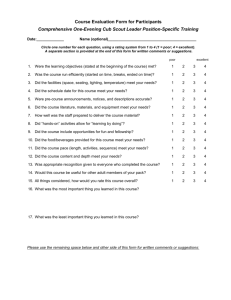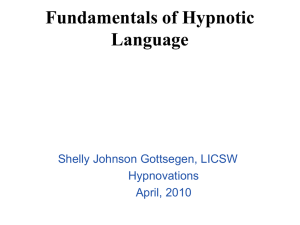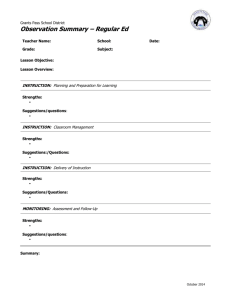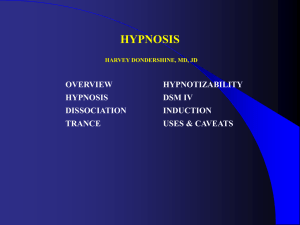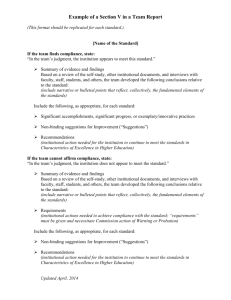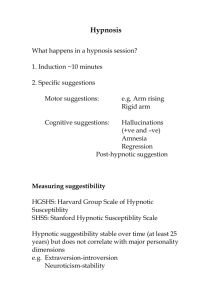HYPNOSIS IN CLINICAL PRACTICE—prepared by Dr
advertisement
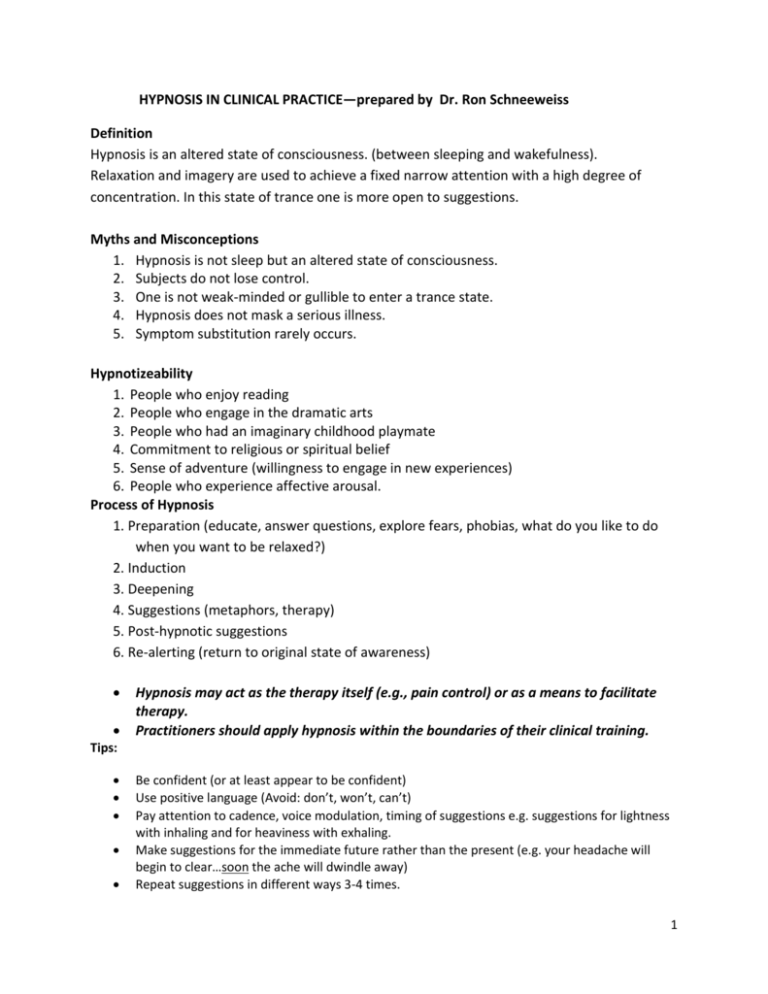
HYPNOSIS IN CLINICAL PRACTICE—prepared by Dr. Ron Schneeweiss Definition Hypnosis is an altered state of consciousness. (between sleeping and wakefulness). Relaxation and imagery are used to achieve a fixed narrow attention with a high degree of concentration. In this state of trance one is more open to suggestions. Myths and Misconceptions 1. Hypnosis is not sleep but an altered state of consciousness. 2. Subjects do not lose control. 3. One is not weak-minded or gullible to enter a trance state. 4. Hypnosis does not mask a serious illness. 5. Symptom substitution rarely occurs. Hypnotizeability 1. People who enjoy reading 2. People who engage in the dramatic arts 3. People who had an imaginary childhood playmate 4. Commitment to religious or spiritual belief 5. Sense of adventure (willingness to engage in new experiences) 6. People who experience affective arousal. Process of Hypnosis 1. Preparation (educate, answer questions, explore fears, phobias, what do you like to do when you want to be relaxed?) 2. Induction 3. Deepening 4. Suggestions (metaphors, therapy) 5. Post-hypnotic suggestions 6. Re-alerting (return to original state of awareness) Hypnosis may act as the therapy itself (e.g., pain control) or as a means to facilitate therapy. Practitioners should apply hypnosis within the boundaries of their clinical training. Tips: Be confident (or at least appear to be confident) Use positive language (Avoid: don’t, won’t, can’t) Pay attention to cadence, voice modulation, timing of suggestions e.g. suggestions for lightness with inhaling and for heaviness with exhaling. Make suggestions for the immediate future rather than the present (e.g. your headache will begin to clear…soon the ache will dwindle away) Repeat suggestions in different ways 3-4 times. 1 Some Induction Wording: I wonder if you will enjoy how naturally, how easily your eyes will begin to close? Notice how comfortable your eyes feel when closing. You can let your eyes remain closed with no effort at all. With every breath you take you increase your sense of inner comfort. The more relaxed you are the less discomfort you will feel…why don’t you let your breathing help you be more relaxed and comfortable? The sounds of the air-conditioner in the background reminds you to relax more and more. As you notice the air temperature around you changing, you can also making internal changes for the better. If I were you I would daydream myself to my favorite place... perhaps a place from your past… or perhaps a place that you will create in your mind’s eye. Some Wording for Suggestions During Trance: Imagine a pleasant scene, either something from your past or a place where you might want to be in your imagination. It should be a situation where you are pleasantly relaxed; not exhilarating; and not boring, just very quiet, very pleasant, very relaxing. If you do not like this or cannot do it, just relax deeper and deeper with your exhalations. Exhale a few times gently, deeply, soothingly, calmly.[Heaviness] Imagine an inner advisor - This can be a wise older person, a friendly animal, a friend. Accept your advisor as he/she/it appears as long as he/she/it seems wise kind and compassionate. You’ve done some healthy things for yourself recently. I believe that you can keep them up! (NOT “Smoking cigarettes is something you should quit doing if you want to feel better!”) You will be feeling better as you use your medication, and as you continue to make improvements in your life-style. (NOT “ Here, take this medication it might help” As you exhale, shake the dust off your mind ……and as you inhale, permit wisdom and knowledge to enter ….exhale. Studying stimulates (inhale) Steady study brings success (inhale) Some useful ideas: balance; naturally centered; sense of harmony; finding new ways; letting go; safely and comfortably; very, very good. 2 You can terminate a trance state at any time. Even in the most unlikely event that the hypno-therapist is called away or G-d forbid, even dies during an induction, you would simply drift into a normal sleep or immediately awake. Post-Hypnotic Suggestions: I would like to leave you with three suggestions: One: Whenever you practice on your own or we work together you will return to as deep a state of trance as you need to be at that time. Two: Any suggestions that you make to yourself or that I might make to you for your benefit, you will carry them out to the best of your ability. Three: When you do arouse yourself and return to a state of full wakefulness you will feel refreshed and alert and able to do everything that you need to do, in full control of all your faculties, without any untoward effects. Re-alerting: In a moment I will count from 1 to 5 (or 1 to 3) and as I do you will gradually arouse yourself, becoming more alert, refreshed and clear-headed. Starting now 1..more and more alert and refreshed…2 etc. ..when you feel safe to return to a state of full awareness/wakefulness … you can take all the time you need…your unconscious (subconcious) mind will signal you by allowing your eyes to open.. in your own time and only when you are ready… open your eyes. Some clinical conditions where hypnosis is used: 1. Obstetrics & Gynecology - hyperemesis gravidarum - labor & delivery - relaxation during gynecologic procedures 2. Anxiety, panic attacks, phobias, insomnia 3. Pain (e.g., headaches, back pain, cancer, treatment of burns) 4. Smoking cessation 5. Dermatologic conditions (e.g., pruritus, eczema, warts) 6. Medical conditions with a high level of anxiety: e.g. asthma, migraine headaches. 7. Cancer: anxiety, nausea & vomiting, pain, visualization for cancer regression. 8. To facilitate psychotherapy. 3 The Informal Use of ‘Hypnosis’ in Clinical Practice: The Language of Healing: Lessons from the hypnosis experience can be applied in our regular practice. This session is directed at the informal application of some of those phenomena. Three important concepts: 1. The mind can pay selective attention to external stimuli. 2. Deep breathing and eye-closure activate the parasympathetic nervous system. 3. If we use language with positive suggestions that convey images that are not tension provoking we are more likely to reduce anxiety and to foster better patient adherence. Examples of using ‘the language of healing’: 1. Giving an injection: a. Don’t use statements like “this will sting like a bee” or “this will feel like the bite of a mosquito”. b. Rather build up positive images that will help the patient be more relaxed e.g.: i. I will use the thinnest needle I have so it will cause you the least discomfort/pain. ii. Why don’t you close your eyes and take some deep breathes to help yourself be more relaxed. Exhale loudly …like so (exhale audibly)…. so I can hear your breathing. Give the injection as the patient exhales. iii. I will inject very slowly (to minimize any discomfort from distension of the tissues). iv. Any discomfort/pain will soon be replaced with a numb feeling. 2. Procedures: i. The preparation for the procedure takes some time. Why don’t you close your eyes, breathe deeply and let your mind wander to a place that you associate with relaxation. ii. I will let you know when I am ready to start the procedure. iii. I will let you know what I am doing before I do it. iv. I will STOP any time you say “stop” so you can tell me what is bothering you. NOTE: The above sequence is particularly effective with procedures like IUD placement. 3. Cool vs Cold and Gel vs Goop: a. Do not use the words ‘this will feel cold’ when applying betadyne, alcohol, or inserting a vaginal speculum rather use the words ‘this may feel cool’. b. Don’t use the words ‘I am going to put some ‘goop’ on the speculum’ rather I am going to apply some ‘gel’ on the speculum to make the exam easier. 4 3. Giving a prescription: i. Be as definite and confident with your diagnosis as you can. ii. I have chosen this medication because it is effective for your condition. iii. Directions: I would like you to ‘use it’ as follows NOT I would like you to ‘try it’. iv. Most people improve in a few days/weeks. v. “You’ll be feeling better as you use your medication regularly and as you continue to make improvements in your lifestyle” NOT “here take this medication it may help” 4. Support for behavior change: You’ve done some healthy things for yourself recently (e.g. stop smoking) . I believe that you can keep it up. This language can be more effective than “Smoking cigarettes is bad for your health, you should quit if you want to feel better”. 5. An effective method to eliminate the gag reflex: a. I need to examine your throat b. Please open you mouth and breathe through you open mouth. c. Do not stick out your tongue. d. If you need to use a tongue depressor, just before you insert it, say: ‘This may make you gag’. e. Do not insert it further than half way and press down only as much as you need to see the pharynx, while the patient continues to breathe through the open mouth. f. If the patient still gags have them pant rapidly. 5
